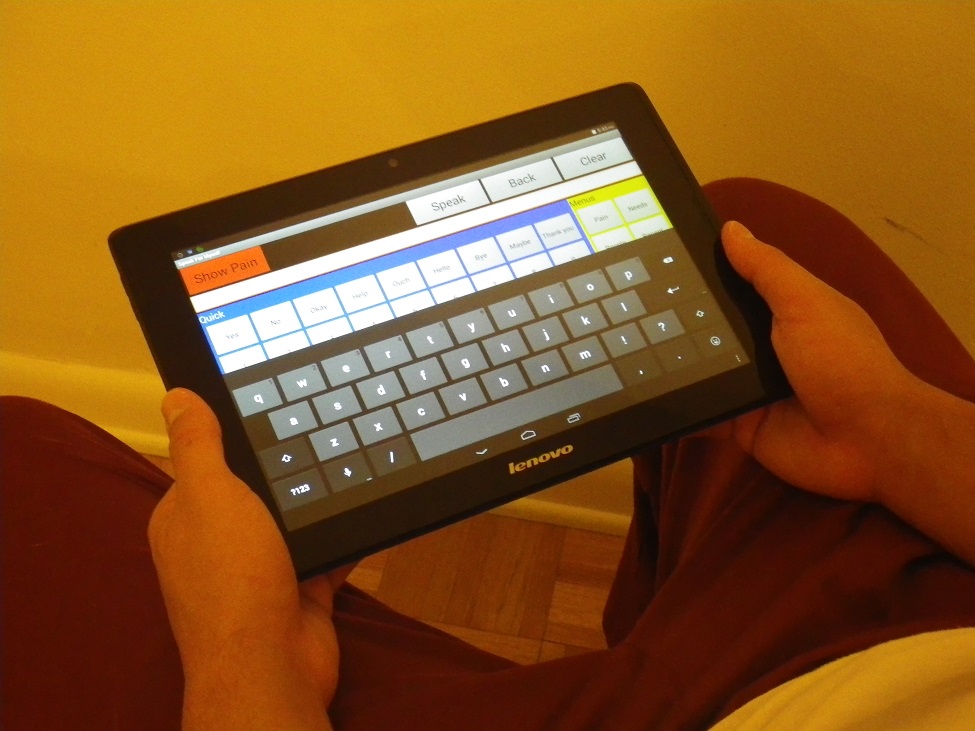New Technology Provides a 'Voice' for Hospitalized Patients
A tablet-based communication application called “Speak for Myself™,” developed at FAU’s Christine E. Lynn College of Nursing, is proving to be an invaluable tool empowering patients who are voiceless.

Speak for Myself™ enables a patient to communicate his or her level of pain using an analog pain scale. It also helps them convey feelings of fear and loneliness as well as their physical needs such as suctioning, repositioning needs and requests for toileting.
There are almost 800,000 patients in the United States who are intubated and require mechanical ventilation annually. More than half of these patients are awake, alert and desperately attempting to communicate with nurses, physicians and their loved ones. Current methods that exist today to assist patients with their communication needs are either antiquated, time consuming or just cumbersome.
A tablet-based communication application called “Speak for Myself™,” was developed by Rebecca Koszalinski, R.N., Ph.D., during her doctoral studies under the guidance of Ruth Tappen, Ed.D., R.N., F.A.A.N., the Christine E. Lynn eminent scholar and professor in the Christine E. Lynn College of Nursing at Florida Atlantic University. Speak for Myself™ is proving to be an invaluable tool empowering patients who are voiceless.
Results of a pilot study of Speak for Myself™, conducted at three hospitals in South Florida, was recently published in the journal Computers, Informatics, Nursing,and demonstrates the importance of this innovative computer app as well as the disconnect between what health care providers think patients want to communicate and what patients actually want to communicate. Subjects in the study ranged in age from 45 to 91 and were hospitalized in intensive care units including cardiovascular, neurological, and surgical ICUs.
“When patients are not able to clearly verbalize their needs, there is an elevated risk of misinterpretation and misunderstanding, which could lead to errors and unintentional poorer quality of care,” said Tappen. “While writing boards and other traditional methods may be helpful, important information is often lost. Furthermore, allowing others to speak for the patient has its limitations.”
Speak for Myself™ enables a patient to communicate his or her level of pain using an analog pain scale. It also helps them convey feelings of fear and loneliness as well as their physical needs such as suctioning, repositioning needs and requests for toileting. The app has a graphic for indicating the location of their pain and the level of pain they are experiencing. When a patient touches the screen to indicate the location of pain on the body graphic, the voice says “it hurts here.” Patients can use shortcuts and single words or type in phrases or full sentences to communicate their needs. The software is predictive so that if a patient begins to enter a word, the program will anticipate and present likely solutions.
“The purpose of Speak for Myself™ is to provide an easy-to-use, patient-centric, and hospital experience-specific program that can assist patients in expressing their needs,” said Koszalinski, now an assistant professor in the College of Nursing at the University of Tennessee, Knoxville. “Patients want to be heard, to retain control, and to contribute to decisions about their care, even if it is without a voice. Technology at the bedside can play a significant role in making this a reality.”
Results from the study revealed to Tappen and Koszalinski just how effective Speak for Myself™ was for both patients and health care providers in the ICUs. In one example, a patient who had reported unresolved pain in the back of his throat was finally able to get assessed properly. Health care providers learned that it was the nasogastric tube that had become twisted and was causing his pain. They corrected the placement of the tube and resolved the issue. Perhaps the most dramatic example for clear communication was demonstrated when a patient asked the nurses to help document her end-of-life decisions and wishes. The patient decided not to prolong treatment but to disconnect the mechanical ventilation that was keeping her alive.
“It is accurate to assert that with enhanced communication, patients will have less frustration, their pain will be better controlled, and they will have a greater opportunity to participate in their own care, and this is all supported in our study,” said Tappen.
FAU’s College of Nursing is internationally known for its commitment to nursing as a discipline focused on nurturing the wholeness of persons and the environment through Caring. The College advances Caring knowledge through education, practice, research and scholarship to transform care locally, nationally and globally. Currently, the College of Nursing offers bachelor’s, master’s, DNP and Ph.D. degree programs with approximately 1,600 nursing students enrolled in its programs. For more information, visit www.nursing.fau.edu.
-FAU-
Tags: research | faculty and staff | students | nursing | technology